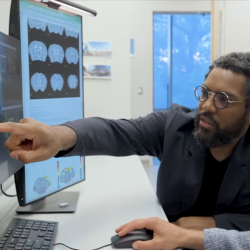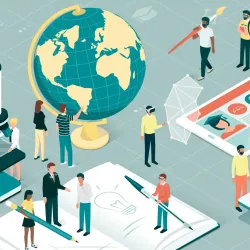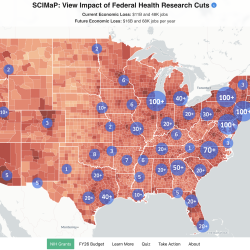UMD Biologist Shares ‘Story of Sex’ in New Book
Eric Haag looks back 2 billion years to explain why humans have sex—and sexes—in a world where neither is a prerequisite for life.
University of Maryland Biology Professor Eric Haag has spent his career studying animal reproduction, but people’s sex lives never factored into his research. That changed in 2014 when a cancer diagnosis prompted Haag to take stock of his career up to that point.
“Thankfully, my treatment worked, but it reminded me that I'm not going to be here forever,” Haag said. “As much as I love the nitty-gritty details of evolutionary biology, there might be 20 people who look forward to my next paper. So I thought, ‘Can I offer the world anything of more general value?’”
Haag concluded that the history of human sex—and sexes—might hold broader appeal than reproduction in nematode worms, which is one of his main research interests. He also recognized a need for greater understanding around divisive issues that stem from living in a “gendered world” —like equity in sports, LGBTQ+ rights or the gender pay gap—so he spent the next eight years putting it all down in a book.

“A few years ago, it struck me that, while the arguments over sexes and gender are undeniably important (and often rather heated), most of those engaged in them have little sense of the deep history of the very phenomenon about which they argue,” Haag wrote in the introduction.
Published by Columbia University Press on December 3, 2024, his first book, “The Other Big Bang: The Story of Sex and Its Human Legacy,” leverages evolutionary biology to answer a central question: “Why do we have sexes (and sex) at all?”
Early on, Haag proposes a thought experiment to challenge readers’ preconceived notions of sex and gender.
“Imagine for a moment what wouldn’t exist if we lived in an alternative, one-sex world: Two types of bathrooms. Sexism. Mother-in-law jokes. Title IX. Sexual orientation and gender identity. Sex-related inequality and the proposed Equal Rights Amendment. Most sexual violence. Before you roll your eyes and say, ‘But that’s science fiction!,’ I need to point out that many animals and most plants live in this one-sex world. This does not mean they are asexual—often individuals are hermaphroditic, serving as both mother and father in a sperm-swapping arrangement with their mate. If that works for so many other organisms, how did we get here?”
As Haag explains in the book’s first section, the origins of human sex can be traced back 2 billion years to early single-celled organisms, the first eukaryotes. They later gave rise to the first plants, animals and eventually humans.
A key feature that separates eukaryotes from simpler organisms like bacteria, a type of prokaryote, is their capacity for fertilization and meiosis, which facilitate the division of cells and the recombination of genetic material in novel ways. Sexual reproduction may have emerged as a “supercharged repair mechanism” to protect cells from DNA damage caused by another eukaryotic novelty—the mitochondrion, Haag explained, but there are other benefits, too. When a species has greater genetic variation, it can more easily adapt to new circumstances and evolve.
While the eukaryotes vary greatly from one life form to the next, Haag said that the underlying processes that enable sexual reproduction aren’t all that different.
“Some people might be inclined to think that what flowers are doing and what we’re doing is totally different, but actually the molecules that make meiosis happen are the same, for the most part, in a petunia and in us,” Haag said. “And that’s because we’re all descended from the first single-cell eukaryotes that were doing sex.”
As Haag reveals in the book’s second section, it wasn’t until much later in the evolutionary tree that distinct sexes emerged.
“Sex actually greatly predates sexes,” Haag said. “In microbes, there’s no male and female. It’s only about 800 million to a billion years later when we get multicellular animals and start to see what we could call male and female traits evolve.”
One theory is that species with a “sperm specialist” and an “egg specialist” emerged to improve the odds that their offspring survive. Compared to hermaphrodites capable of producing both sperm and eggs, these specialists—or sexes with distinct anatomical parts—can devote more energy and resources to their respective reproductive tasks, improving the genetic fitness of their young.
After covering the distant past, Haag devotes the third and final section of his book to the many ways in which sex and gender manifest in modern human societies. He acknowledges that while some features of sex are the result of billions of years of evolution, modern humans have more choices than ever before in terms of how they choose to express their gender or whether they want to have children.
“We’re in a messy transition where our biology and our sexualized selves were once somewhat deterministic but no longer need to be,” Haag said.
Ultimately, Haag hopes his book will give readers a better understanding of modern society while also providing fodder for “informed agitation”—those difficult but necessary conversations that will help bend the arc of history toward gender equality.
“If people had a better appreciation of how we got here, they might still yell and scream at each other,” Haag said, “but they would at least do so from a more informed standpoint.”







